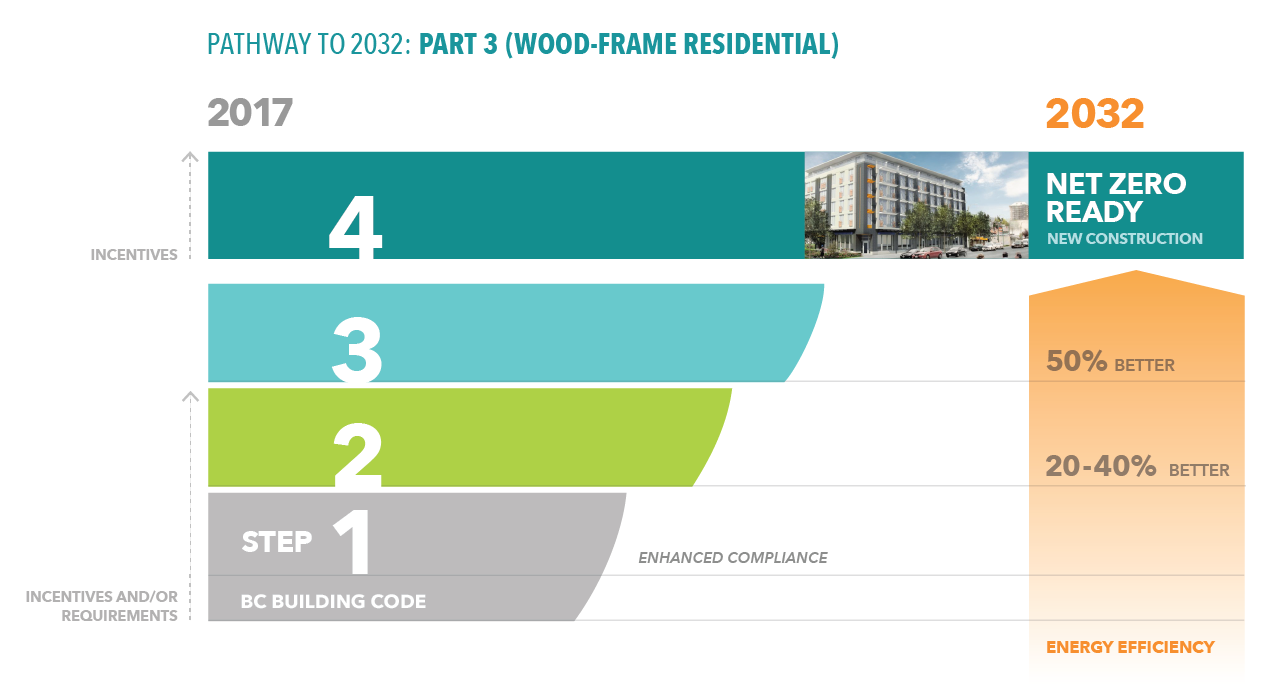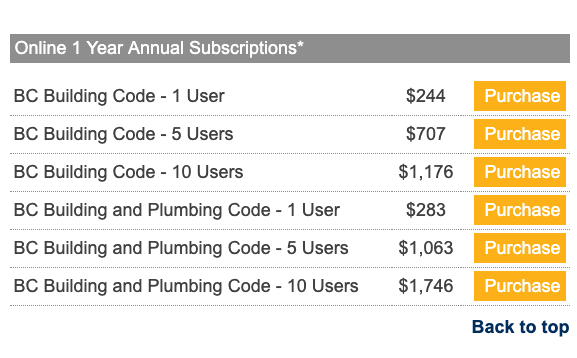THE BC ENERGY STEP CODE EXPLAINED
This is Part 1 of a 3-part series on explaining Green Building, Construction and Renovations in Metro Vancouver.
On December 15, 2017, The BC Energy Step Code went into effect. If you weren’t in the middle of planning a new home build at the time, you might not have even realized it – changes in building efficiency regulations don’t often make the front page of the paper or the Global News headlines.
But if you’re planning a renovation or new build now that Step is in effect, it helps to understand what the government requires of you (or your builder) to get their stamp of approval. So we wrote this article.
What is the BC Step Code?
The BC Energy Step Code is a single set of goal-oriented efficiency standards that the Province of BC is steadily pushing every municipality to adopt and enforce. The term ‘Step’ comes from the rollout method of these efficiency standards – they step up like stairs. The bottom step is essentially the BC Building Code Minimum, and the top step is what BC expects to be the new normal in 2032 – a super-efficient home that produces more energy than it requires.
How can I learn about the BC Step Code?
If you don’t live and breathe construction like we do, learning about various building codes on your own is tough. While official Step press releases and their attached PDFs are often vague (see below), accessing in-depth references like the BC Building Code, which Step ‘builds’ from, is costly and complicated (see below, again).

The above graphic isn’t exactly giving many answers to the questions it creates, and the image below highlights just how tough it can be to even see the codes that builders need to reference.

If you found this article, you were probably curious about Step, and noticed how hard it is to find and understand specifics. To help, we’re going to address some of the most common questions and misconceptions about The BC Energy Step Code, and Green Building in general.
Please note that we are broadly speaking to Step as it applies to residential, single-family homes. As with any legal framework, aspects of Step may change in between the time of posting this article and the time of your reading.
Here we go!
Does the Step Code make the rules for every aspect of a build project?
Not necessarily. Since it’s goal-based, the Step Code is focused on the outcomes of the project rather than the steps (no pun intended) taken to get there. That means creative builders like us can find ways to meet the prescribed standards, while still putting an emphasis on the needs of our future homeowners. Previous frameworks, some of which Step is intended to replace, were far more about the ‘how’ than the end result.
As the name implies, Step is an Energy code, intended to modernize the province’s buildings while creating better environmental outcomes through reduced energy consumption. The Step Code doesn’t concern itself much with specific materials or processes, it concerns itself with the overall efficiency of buildings.
Does the Step Code have any impact on my renovation?
No. Unless your renovation is so substantial that it becomes a ‘new build’, you don’t need to worry about the Step Code. That being said, some municipalities have created incentives to push you towards Step standards. For example, North Vancouver currently incentivizes renovations that make the cut with rebates from FortisBC.
It’s important to note that, all incentives aside, renovating up to higher efficiency standards will always drop your energy bills and create a more comfortable space. It also helps with resale value going forward.
Is the Step Code related to LEED or other ‘green’ building programs?
No. While the BC Energy Step Code materials draw some comparisons between certain Steps and current accreditation programs, these programs are all run by separate governing bodies:
STEP 1: EnerGuide Rating System, Built Green Bronze
STEP 2: Built Green Silver
STEP 3: ENERGY STAR, Built Green Gold and Platinum
STEP 4: R2000
STEP 5: Passive House, Net-Zero Energy Ready
Real-life example: If you’re building a new home in North Vancouver, adhering to the Step is not optional. However, a builder could choose to adhere to extra standards if they want to go above and beyond. Kennedy Construction, for example, builds to (or above) Step requirements where applicable and also opts into programs from Built Green Canada and Passive House Institute. In some ways, these set an even higher bar than Step requires, and in other ways, they align with code requirements.
Which level of government has the final say in building efficiency standards?
In British Columbia, your municipality has the final say. The municipality has to meet provincial requirements, at a minimum, so you are safe following your municipality’s lead. Over the next decade and a bit, those municipalities’ rules will fall in like with Step.
Is Step the rule everywhere in BC?
No. While many municipalities have adopted Step practices, or are phasing them in, others are not yet using Step as their standard. The City of Vancouver actually has its own regulations which are slightly more stringent than Step, and there are a few municipalities that have not declared any formal reliance on Step.
BC Step is currently treated as an optional program for a reason. It gives municipalities time to adjust, educate, and incentivize builders to get the skills needed to adhere.
If you’re curious, the provincial government keeps a running list of municipality implementation updates here.
Fun fact: North (our home base) and West Vancouver were the first municipalities to make Step the standard!
Are all builders and contractors equipped for these new efficiency standards?
Unfortunately not. This is one of the reasons these efficiency standards were rolled out the way they were – to make it clear that builders and trades need to upgrade their efficiency skills, without putting stragglers out of business immediately.
Anecdote: recently (to the time of writing), a Step inspector came by one of our new builds, which was ready for final testing. He had been to five sites that day – and only two sites passed efficiency tests – ours being one.
We prefer to lead the pack, not catch up at the last moment. That’s why our own president, Andrew Kennedy, built his own home to higher standards than required. (If you’d like to see how he did that, check out this article for a tour with Andrew and HGTV’s Todd Talbot).
And, if you’d like some insights on choosing a cutting-edge green builder vs. a builder doing the minimum, we have a handy article about that, as well.
What is the risk of using a build partner that isn’t an expert on Step requirements?
Just as we talked about in our article on permitting pitfalls, there is a large risk of lost time, sunk costs, and fines. Remember that any credible builder will be happy to outline their experience, recent education updates, and partnership policies with you.
The absolute worst-case scenario of failing to meet requirements is a teardown, but what’s more likely (and far more common than you might think) is your builder needing to go backward and make improvements to large components of the project, like your envelope’s airtightness. (We talk about that in Part 2 of our series).
I’m building a new house in the next few years – should I just make it Step 5 compliant?
Creating a high-efficiency, net-zero home is a great idea for a lot of reasons. Comfort. Resale value. Lower heating bills. Doing the right thing for the environment. In North and West Vancouver, where we do most of our work, Step 3 is already the minimum. But those two steps – from 3 to 5 – are big jumps.
Going all-in on Step 5 is a great conversation to have with your builder. The benefits are obvious. But, as noted in the Step guide, there is a logic to pushing Step 5 back to 2032 – the potentially reduced costs of technologies and systems you’ll need to bring that Step 5 home to life.
Solar panel pricing (based on energy created) dropped around 62% between 2010 and 2017. It will drop again, especially as companies like Tesla’s SolarCity bring more competition to the market. When our president Andrew built his home a few years ago, he installed roofing that’s intended to make the installation of solar easier and cheaper next year. That’s the kind of planning discussion you can have with your builder.
Additionally, home automation products have gone from a tool for the wealthy to something Spotify gives away with a subscription. Home automation products can help with energy consumption and home comfort in a big way.
All that being said, you and your builder need to weigh the pros and cons of going above and beyond. It’s your home, your money, and your decision. At Kennedy Construction, we’re happy to go through your options, and talk about potential savings gained vs. the upfront investment in a higher Step. High-efficiency homes are our specialty, and we can also talk about ways to build for right now, while making it easy to transition to a net-zero home when you’re ready.
Hopefully, this article answered some of your questions about the BC Step Code and how it may (or may not) affect you. If you have any more questions about the Step Code, send us an email at info@kennedyconstruction.ca! We may even add your question to this article to help others.
Did you like this post?
You might enjoy the Part Two – Green Home Build Tour and Part Three – How Do You Choose The Right Green Builder?.